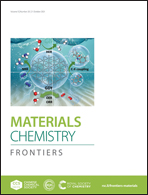Triethyl phosphate in an antisolvent: a novel approach to fabricate high-efficiency and stable perovskite solar cells under ambient air conditions†
Abstract
Organometallic halide perovskite solar cells (PSCs) with a high power conversion efficiency (PCE) have attracted immense attention for applications and commercialization. Nevertheless, it is still a challenge to find a novel method to overcome the rapid degradation of the perovskite so that PSCs demonstrating an excellent performance can be fabricated in an ambient environment without a glove box. Herein, in this paper, triethyl phosphate (TEP) is introduced into the perovskite layer via antisolvent engineering to serve as a crystallization aid and a humidity stabilizer. Impressively, the electron-rich phosphate group in TEP can form a strong chemical bonding interaction with the perovskite (Pb–O) to passivate the defects produced during crystallization. More interestingly, the ethyl group with its hydrophobic effect can protect the perovskite film from corrosion by the moisture in the air. As a result, the TEP-modified perovskite film demonstrates a dense and defectless morphology with a large grain size (a maximum of more than 1 μm). The TEP-treated device achieves a dramatic efficiency of 19.6% and negligible hysteresis of the photocurrent. Moreover, the humidity resistance of the TEP-modified device is significantly enhanced. The normalized PCE of the TEP-modified device (unencapsulated) can still retain 82% of its initial value after being stored in an 85% humidity environment under dark conditions for 400 hours. This finding provides a promising approach for facilitating the commercialization of PSCs.



 Please wait while we load your content...
Please wait while we load your content...